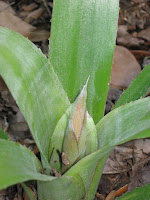I took the week off - one would think that I took a vacation from this blog, but that's not true. I've been hard at work volunteering at the Master Gardener's office, planting fruit trees at Cypress Gardens, and building a chicken fence at home - and, if I have time, building a few rain barrels.
I'm always afraid that I will procrastinate when I take time off from work - I never seem to get everything done that I had planned. This has not been one of those times. My main project was building a chicken fence. We've had some hawk attacks, and we are also tired of the chickens having the run of the yard, so a fence was in order. It's been planned for a long time, but it finally got built this week - as of this writing, everything but the gate is finished. I started out the week very motivated, and the fence was probably three-quarters finished by Monday night. I had hopes that I could finish by then, because the next two or three days would be busy.
When I had my week off planned, the first thing I scheduled was a double shift at the Master Gardener's office. I wasn't sure how I would feel about working the whole day, but, while the morning crept by slowly, the afternoon was very busy which made time fly. Also I managed to work on the fence for a short time before and after volunteering.

On Wednesday I was scheduled to volunteer planting trees at Cypress Gardens in the morning. I don't usually prefer these kind of volunteer activities, mainly because I feel like I have similar things I can do in my own yard, but I saw an opportunity - I was getting into Cypress Gardens for free, I was getting lunch, and I was planning to spend the afternoon exploring the swamp. There was a lot of walking to sites where we were going to plant these trees - they were starting a fruit orchard and we were planting these, mostly bare root, trees in a couple of different locations. The dozen or more volunteers made short work of the plantings and we were fed lunch. Afterward I spend a couple of hours walking the four plus miles of trails through the cypress swamps. All of the signs telling you to watch out for alligators became a little unnerving, but I only heard one the whole time I was there.
I thought I would be completely free to do other things by Thursday, but I spent a little more time on the fence, reaching the point of almost finishing the gate. By the evening, I felt like the week was almost over, but in reality I have three whole days left - plenty of time to do a few more things around the house...

Two of those three days are gone now without much to show for it - at least around the house. I never really took a whole day off the entire week, so that's what happened on Friday. It was a good idea too - the cold and flu that I had missed when it happened at my house earlier this year landed at my feet Thursday night. Luckily I'm only talking about a cold. It hasn't been bad, but I wish I didn't have it - and I go back to work on Monday. So, Saturday, after it warmed up, I was able to finish the gate, so the chickens will have a smaller area to call their own now. I do have a few more details to finish - cut and attach boards so the gate looks like the rest of the fence, and block off a small area between the garage and the fence. I also have to remove our clothesline that now crosses the fence and put up an umbrella-style one. I'm in the process of running fishing line over the entire area to deter any hawk attacks as well. I've heard this a number of places - I hope it works. Another possible long-term goal is to put up additional rows of fence boards to make it look more like a fence.
More on the outcome of the fence later.















